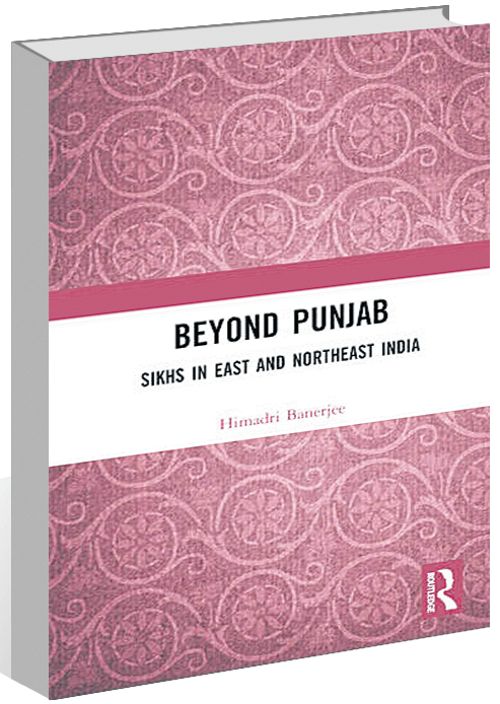Beyond Punjab: Sikhs in East and Northeast India by Himadri Banerjee. Routledge. Pages 180. Rs 1,295
Book Title: Beyond Punjab: Sikhs in East and Northeast India
Author: Himadri Banerjee
Nina Singh
THE book’s title is self-revealing. It is about Sikh communities living in east and northeast India outside their cultural core, the Punjab, which before Independence included parts of northwest India and Pakistan.
Studies on Sikhs in Punjab put them as homogenous and Khalsa-centric. ‘Beyond Punjab: Sikhs in East and Northeast India’ breaks the narrative of a monolithic Sikh identity held by Singh Sabha emerging in the late 19th century (1873-1909), and projects things from a new perspective. In a first of its kind, the text unveils enormous plurality and diversity among adherents of the Sikh faith outside colonial Punjab, where they have made room for home, memory and identity.
In a nuanced notion of a diaspora, the text revolves around space and place, mobility, locatedness, resettlement, connection and attachment. The internal Sikh diaspora in India outside Punjab had emerged in precolonial times, accommodating Sikhs of dissimilar ethnic, territorial, linguistic, and cultural backgrounds.
The author delves into oral sources, besides secondary and tertiary, to decipher how the native Sikhs endeavoured to link their past with the history of the Sikhs of Punjab. The book also mirrors the voices of migrants, generally missed in Punjab-focused studies. In that tone, it shifts its gaze from a book-view to a field-view of Sikhs.
The Sikh religion and philosophy were founded in the Punjab region of the Indian subcontinent in the late 15th century by Guru Nanak Dev (1469-1539). The journeys of the Sikhs initiated by their Gurus began sometime in the 16th century. Nanakpanthis and Udasis stimulated the birth of native Sikhs in different regions.
Initially, most migrant Sikhs from Punjab were the Khatris, traders who settled in Bihar towards the east or neighbouring lands to the west. The Sikh migrants of the colonial period, such as the Jats, Ramgarhias and Dalits, represented heterogeneity of castes, territorial backgrounds, and differing perceptions of Sikh identity.
Himadri Banerjee’s book, structured into six chapters — Bihar, Odisha, Kolkata, Assam, Shillong, and Manipur — highlights regional differences within the Sikh community, the dissimilarities in the relationship of immigrant populations with their host society, and the levels of cooperation and competition in their ranks. To cite some cases from the chapters, the immigrant settlements in rural Assam, coastal Odisha, and urban Bihar stimulated their adaptation of local languages, religious beliefs, and social practices. The native Sikhs or endogamous groups, on the other hand, are examples of how the tenets of Sikhism were adapted in India outside Punjab.
Kolkata’s urbanisation focuses on phases of Sikh migration and settlement and their impact on the ethnic identity of Kolkata Sikhs. The Shillong story unveils that the Sikh communities outside Punjab are not altogether beyond the limits of caste, social differentiation or the domination of a few rich over the more numerous sections of local Sikhs. Manipur is an example of a fractured community identity following bitter competition, which led to the dispersion of Sikhs from Imphal.
Creating sacred spaces is most central to the Sikh faith. Immigrants had set up gurdwaras at new settlements to observe religious practices, perpetuate Sikh traditions, provide rites of passage to individuals, and hold community celebrations to reinforce their identity. Caste-based conflicts over appropriation and use of their sacred space, the gurdwara, as much as the cultural conflict in the relationship between the immigrant Sikhs and the native Sikhs at the six eastern and northeastern Indian sites, underlines that Sikhism, like other world religions, is not devoid of rivalry, hierarchy, or conflict.
The book establishes that Sikhism, like other major religions, exhibits a ‘variety of localised adaptations and responses’ not known to its ‘cultural core’.
This work within the domain of Sikh Studies deconstructs the homogenising narrative of modern Sikhism and points to the emergence of a refreshing frontier in the discipline. It lives up to its expectations and must be read in its space and time context.
The book will be a good read for scholars of social sciences, including sociology and history, particularly Sikh history, social anthropology, religion, migration and diaspora studies, as well as general readers.














